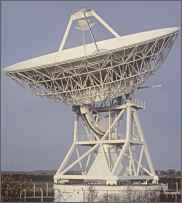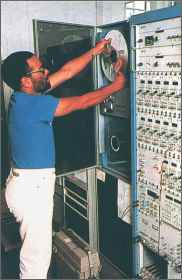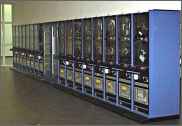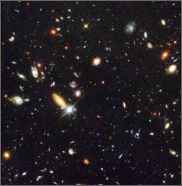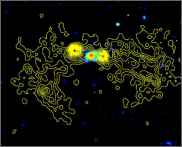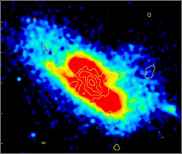
|
The Merlin and VLBI National Facility |
|
The
array of telescopes now known as MERLIN, the Multi-Element Radio-Linked
Interferometer Network, first came into operation in 1980. The
signals from five remote 25-metre telescopes, having a maximum
separation of 134 km, were brought back over microwave radio
links to Jodrell Bank. Here they were combined with signals
from the Mark II or Lovell telescopes in a "correlator"
which provided the raw data from which detailed images of radio
sources could be produced in a computer. In a major upgrade
to MERLIN, completed in 1991, a new 32-metre telescope was built
at Cambridge to increase the maximum telescope separation to
217 km. This now gives MERLIN a typical resolution of 1/20 of
a second of arc, equivalent to resolving a one-pound coin from
a distance of 100 km. To make the system more sensitive, the
bandwidths of the microwave links were doubled and a new, multi-bit,
correlator built to combine the data more efficiently. Very Long Baseline Interferometry (VLBI) Even higher resolution than that achievable with MERLIN can be obtained by combining the signals from widely spaced telescopes in VLBI arrays. Jodrell Bank Observatory is a founder member of the European VLBI Network (EVN) whose telescopes span Europe from Spain to Finland and from the United Kingdom to Poland. The EVN now has a dedicated facility, JIVE (the Joint Institute for VLBI in Europe), at Dwingeloo in the Netherlands, where its new wideband correlator is located. Unlike MERLIN, where the data are combined together (correlated) in real time, the data received at the EVN telescopes are recorded on tape and played back weeks or months later at the correlator. Jodrell Bank computer and engineering staff made significant contributions to the development of the EVN correlator which combines the signals to allow radio source images to be made with angular resolutions as small as 100 microarcseconds. The 32-metre telescope at Cambridge and either the Lovell or Mark II telescopes at Jodrell Bank spend around 12 weeks each year as part of the EVN array. At wavelengths of 18 cm and longer the Lovell Telescope is used, whilst the Mark II is used for wavelengths of 6cm and below. The upgraded Lovell Telescope will significantly enhance the performance of the EVN at 5 and 6cm wavelengths. Due to the number of large telescopes participating, including the 76-metre Lovell Telescope, the Westerbork array in Holland and the 100-metre Effelsberg Telescope in Germany, the EVN provides the highest sensitivity VLBI array in the world. The National Facility The
MERLIN and VLBI systems at the Jodrell Bank Observatory are
now operated as a National Facility by the University of Manchester
on behalf of the Particle Physics and Astronomy Research Council
(PPARC). Its remit is to operate MERLIN for the benefit of the
whole astronomical community and to MERLIN's
strengths The
Future: e-MERLIN Optical Fibres The most significant part of the development would be the replacement of the current microwave links with optical fibre links. These could carry a bandwidth of 4 GHz compared to the 28 MHz of the current links. With a new correlator capable of processing these wide-band signals the result would be an order of magnitude increase in MERLIN's sensitivity. If this is allied to improvements in the low-noise receivers, and the incorporation of the upgraded Lovell Telescope into the array at wavelengths below 18cm, the sensitivity of e-MERLIN will up to 30 times that of the current system! Receivers
and the Defford Telescope MERLIN/VLA
observations of the Hubble Deep Field
|
